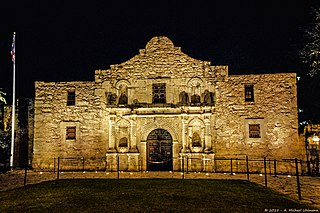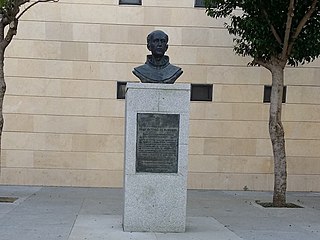
San Antonio, officially the City of San Antonio, is a city in the U.S. state of Texas and the most populous city in Greater San Antonio, the third-largest metropolitan area in Texas and the 24th-largest metropolitan area in the United States at 2.6 million people in the 2020 US census. It is the most populous city in and the county seat of Bexar County. The city is the seventh-most populous in the United States, the second-largest in the Southern United States, and the second-most populous in Texas after Houston.

Bexar County is a county in the U.S. state of Texas. It is in South Texas and its county seat is San Antonio.

The Alamo is a historic Spanish mission and fortress compound founded in the 18th century by Roman Catholic missionaries in what is now San Antonio, Texas, United States. It was the site of the Battle of the Alamo in 1836, a pivotal event of the Texas Revolution in which American folk heroes James Bowie and Davy Crockett were killed. Today it is a museum in the Alamo Plaza Historic District and a part of the San Antonio Missions World Heritage Site.

The Spanish Missions in Texas comprise the many Catholic outposts established in New Spain by Dominican, Jesuit, and Franciscan orders to spread their doctrine among Native Americans and to give Spain a toehold in the frontier land. The missions introduced European livestock, fruits, vegetables, and industry into the Texas area. In addition to the presidio and pueblo (town), the misión was one of the three major agencies employed by the Spanish crown to extend its borders and consolidate its colonial territories. In all, twenty-six missions were maintained for different lengths of time within the future boundaries of the state of Texas.

The San Antonio River is a major waterway that originates in central Texas in a cluster of springs in midtown San Antonio, about 4 miles north of downtown, and follows a roughly southeastern path through the state. It eventually feeds into the Guadalupe River about 10 miles from San Antonio Bay on the Gulf of Mexico. The river is 240 miles long and crosses five counties: Bexar, Goliad, Karnes, Refugio, and Wilson.

San Pedro Springs is the name of a cluster of springs in Bexar County, Texas, United States. These springs provide water for San Pedro Creek, which flows into the San Antonio River. The San Antonio Springs also feed into the San Antonio River.

Greater San Antonio, officially designated San Antonio–New Braunfels, is an eight-county metropolitan area in the U.S. state of Texas defined by the Office of Management and Budget (OMB). The metropolitan area straddles South Texas and Central Texas and is on the southwestern corner of the Texas Triangle. The official 2020 U.S. census showed the metropolitan area's population at 2,558,143—up from a reported 1,711,103 in 2000—making it the 24th largest metropolitan area in the United States. Downtown Austin and Downtown San Antonio are approximately 80 miles (129 km) apart, and both fall along the Interstate 35 corridor. This combined metropolitan region of San Antonio–Austin has approximately 5 million people.

La Villita Historic Arts Village is an art community in downtown San Antonio, Texas, United States. There are art galleries, stores selling souvenirs, gifts, custom jewelry, pottery, and imported Mexican folk art, as well as several restaurants in the district. La Villita connects to the San Antonio River Walk and its outdoor venue, the Arneson River Theatre. It is close to the Alamo, the Henry B. Gonzalez Convention Center, Rivercenter Mall, and HemisFair Park. It is within walking distance of most downtown hotels.

The New Philippines was the abbreviated name of a territory in New Spain. Its full and official name was Nuevo Reino de Filipinas.
Martín de Alarcón was the Governor of Coahuila and Texas from 1705 until 1708, and again from 1716 until 1719. He founded San Antonio, the first Spanish civilian settlement in Texas.

San Pedro Springs Park is located in the Bexar County city of San Antonio in the U.S. state of Texas. Surrounding the source of the springs, the 46-acre park is the oldest in the state of Texas. It is the location of a Payaya Indian village known as Yanaguana, and is the original site of the city of San Antonio. The park is alternately known as San Pedro Park. The park was designated a Recorded Texas Historic Landmark in 1965. It was added to the National Register of Historic Places listings in Bexar County, Texas on November 1, 1979.

The City of San Antonio is one of the oldest Spanish settlements in Texas and was, for decades, its largest city. Before Spanish colonization, the site was occupied for thousands of years by varying cultures of indigenous peoples. The historic Payaya Indians were likely those who encountered the first Europeans.

Antonio de San Buenaventura y Olivares or simply Fray Antonio de Olivares was a Spanish Franciscan who officiated at the first Catholic Mass celebrated in Texas, and he was known for contributing to the founding of San Antonio and to the prior exploration of the area. He founded, among other missions, the Alamo Mission in San Antonio, the Presidio San Antonio de Bexar, and the Acequia Madre de Valero.
Isidro Félix de Espinosa (1679–1755) was a Franciscan missionary from New Spain who participated in several expeditionary missions throughout the province of Tejas. He was the president of the missionaries from the College of Santa Cruz de Querétaro.

Presidio de Béxar was a Spanish fort built near the San Antonio River, located in what is now San Antonio, Texas, in the United States. It was designed for protection of the mission San Antonio de Valero and the Villa de Béjar. The Presidio de Béxar was founded on May 5, 1718 by Spanish colonial official Martín de Alarcón and his party of thirty-five soldiers. The Villa de Béjar is known for being the first Spanish settlement of San Antonio and consisted of the families of the Presidio Soldiers and those of the prior expeditions. It also served to secure Spain's claim to the region against possible encroachment from other European powers.
Mission San Francisco Solano was a Spanish mission established March 1, 1700 by Franciscan missionaries. Along with Mission San Juan Bautista, Mission San Bernardo, and the nearby San Juan Bautista presidio, it belonged to a complex collectively known as the San Juan Bautista Missions.

The Payaya people were Indigenous people whose territory encompassed the area of present-day San Antonio, Texas. The Payaya were a Coahuiltecan band and are the earliest recorded inhabitants of San Pedro Springs Park, the geographical area that became San Antonio.

Acequia Madre de Valero is an 18th-century agricultural irrigation canal built by the Spanish and located in the Bexar County city of San Antonio in the U.S. state of Texas. When Martín de Alarcón founded San Antonio for Spain by establishing San Antonio de Valero Mission in 1718, Franciscan priest Antonio de Olivares and the Payaya and Pastia peoples, dug Acequia Madre de Valero by hand. It was vital to the missions to be able to divert and control water from the San Antonio River, in order to grow crops and to supply water to the people in the area. This particular acequia was the beginning of a much wider irrigation system. Acequia Madre de Valero ran from the area currently known as Brackenridge Park southward to what is now Hemisfair and South Alamo Street. Part of it that is not viewable by the public runs beneath the Menger Hotel. The acequia was restored in 1968 and that same year was designated a Recorded Texas Historic Landmark.

The Johann and Anna Heidgen House is located in the Bexar County city of San Antonio in the U.S. state of Texas. It is listed on the National Register of Historic Places listings in Bexar County, Texas. The structure was designated a Recorded Texas Historic Landmark in 2003. It is also known as the Heidgen-Zilker House. The house was built circa 1882 and has been used for a variety of purposes, including as a residence, as a youth organization facility, attorney's office, wedding venue, and at one time as a restaurant.

The following is a timeline of the history of the city of San Antonio, Texas, United States.
















